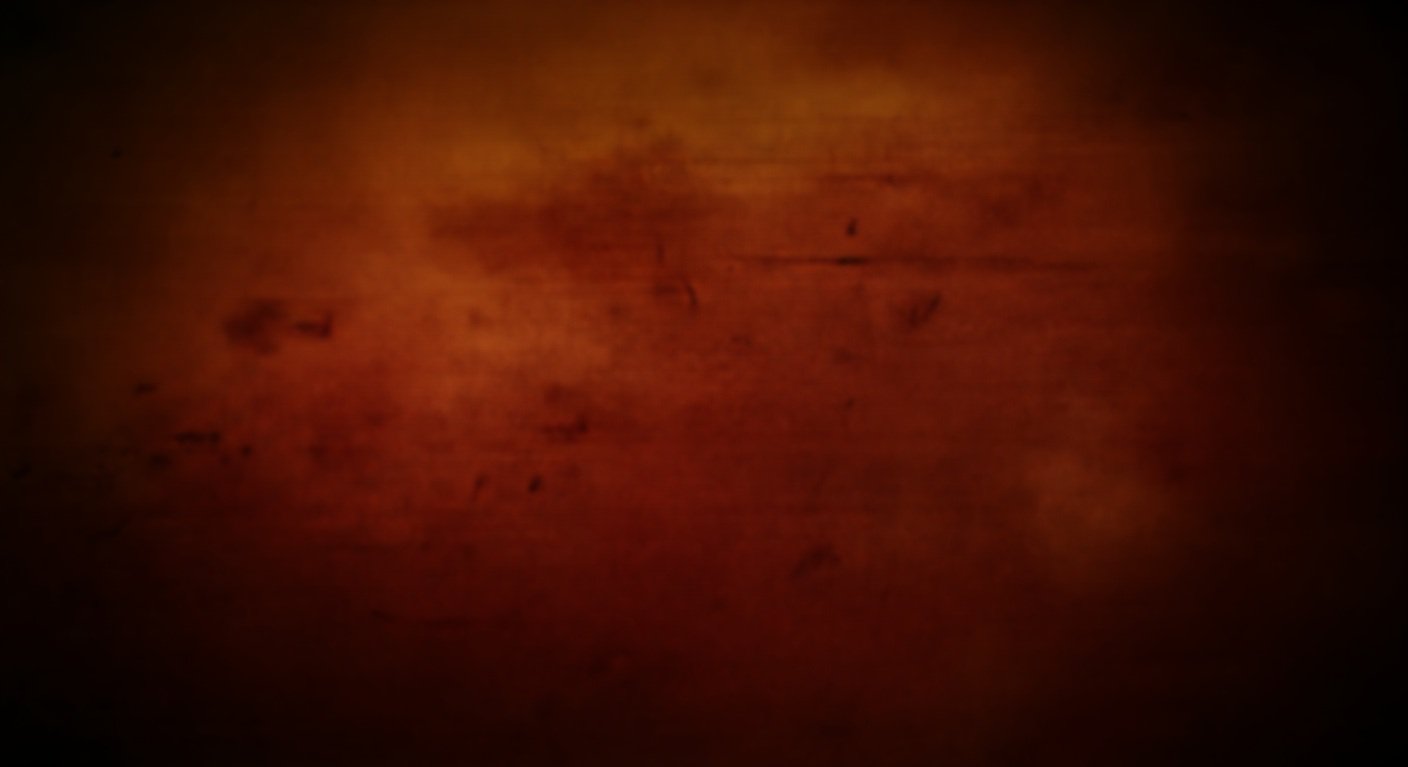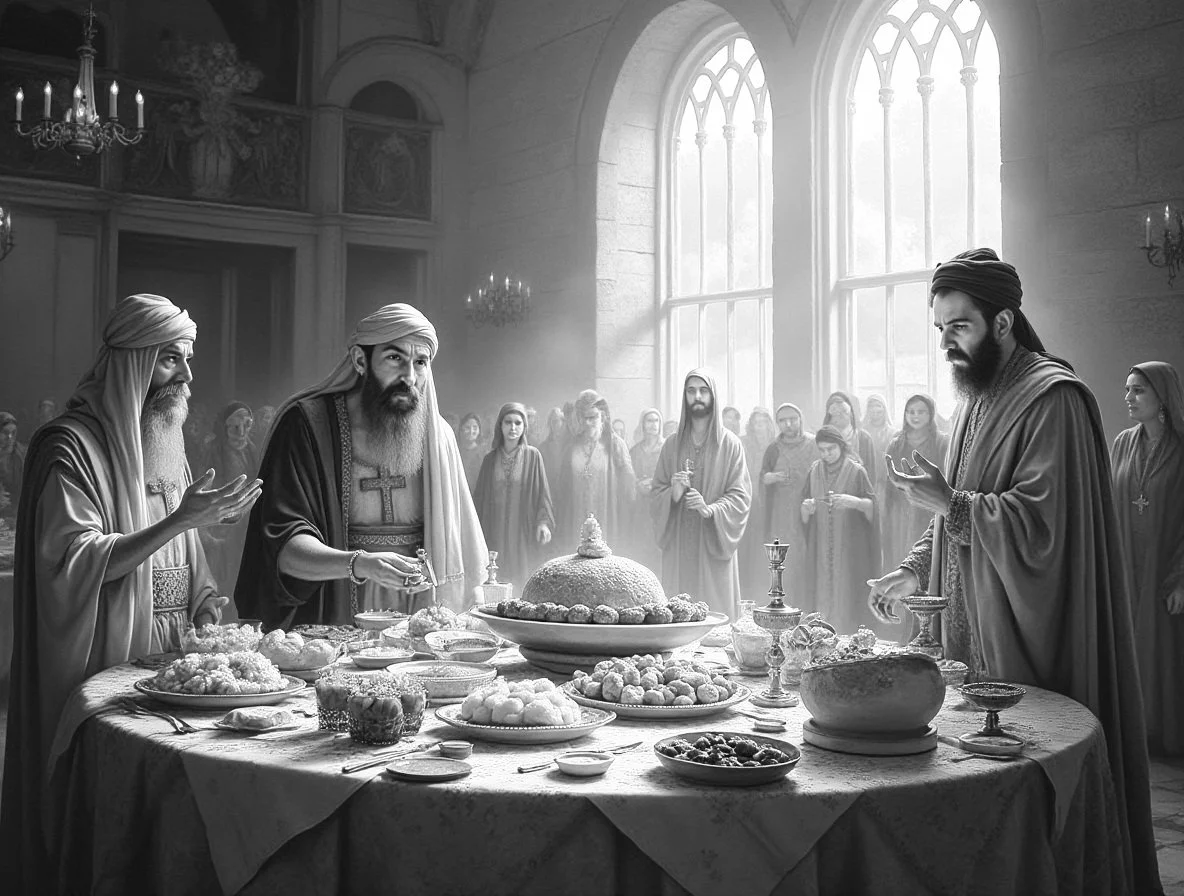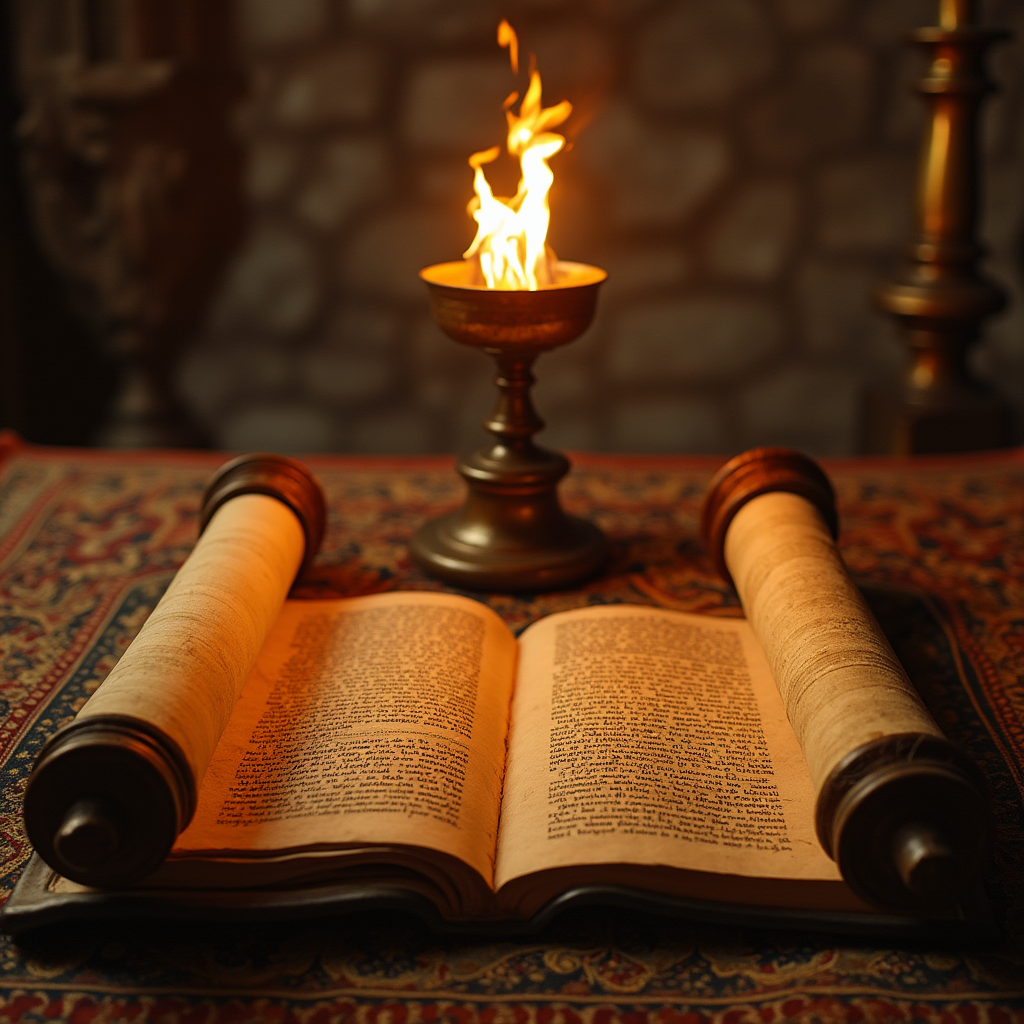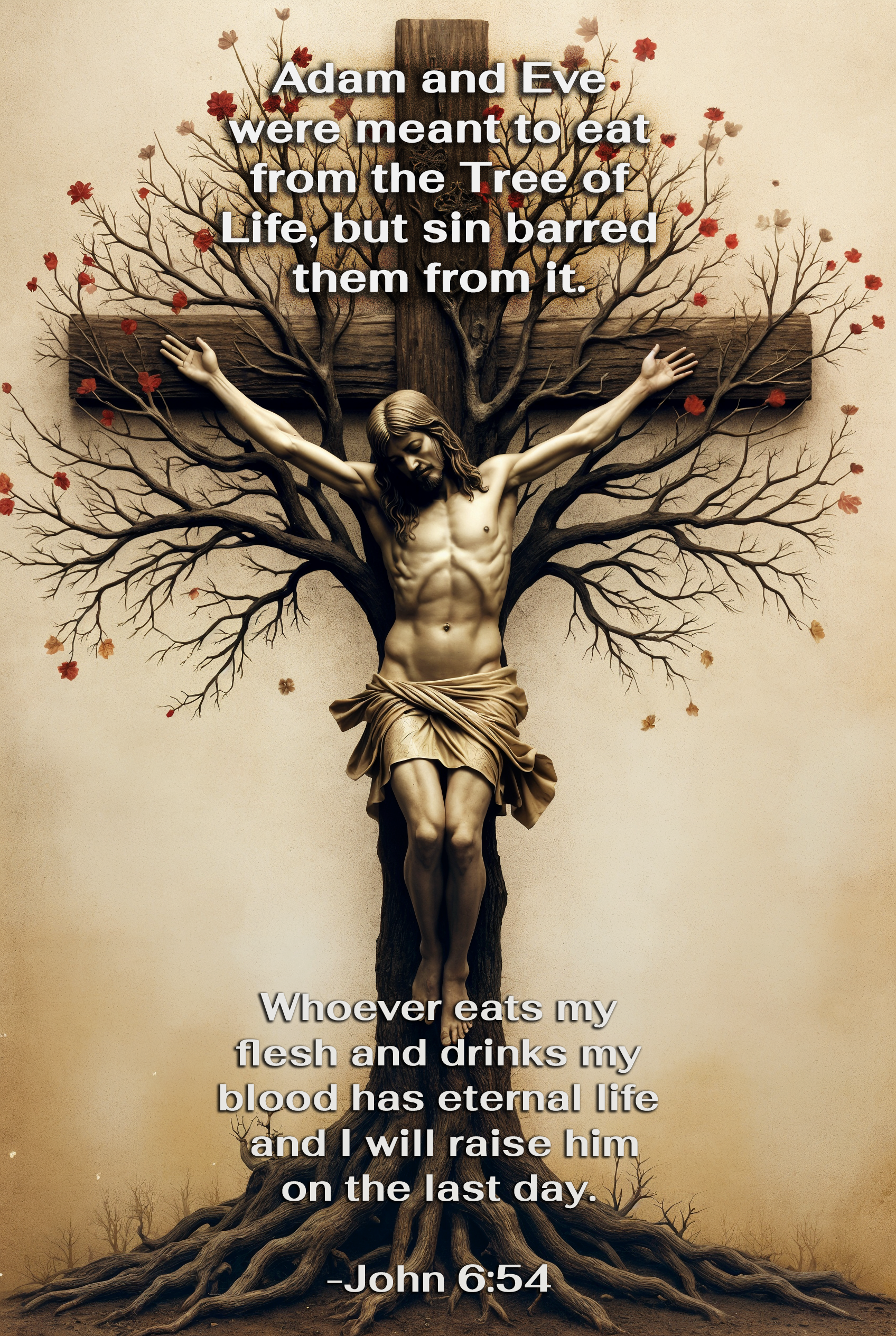
The Eucharist

At the heart of every true love story is a gift. A total giving of self. In the Holy Eucharist, Christ offers the greatest love the world has ever known: His Body, Blood, Soul, and Divinity, poured out for us. This is not merely a symbol, but a living encounter with Love Himself, believed by millions to be truly present under the appearance of bread and wine. The Eucharist is the source and summit of the Christian Life, the place where heaven touches earth and hearts are forever changed.
Step Into the Mystery - God’s Life, In Us.
There From The Beginning
In the Old Testament, sacrifices were central to Israel’s worship and relationship with God. These offerings, commanded by God (Leviticus 4–5), were primarily made to atone for sin, both intentional and unintentional. They taught the people that sin had real consequences, and that reconciliation with God required a costly, heartfelt act. Sacrifice wasn’t just about loss. It was about love, repentance, and restoring communion with God.
From the time of Noah and Abraham (Genesis 8:20; 22:2) through Moses (Exodus 24:5–8), the people of God offered animals, grain, or other goods. These were symbolic, imperfect offerings that pointed forward to something, someone, greater. The prophets foretold a new covenant, not written on stone but on hearts (Jeremiah 31:31–34), and a suffering servant who would bear the sins of many (Isaiah 53).
Jesus and the New Passover
This promise of Isaiah 53 is fulfilled in Jesus Christ, whom John the Baptist calls “the Lamb of God who takes away the sin of the world” (John 1:29). Jesus’ death on the Cross is not a tragic accident, it is the climax of God's saving plan, perfectly timed to occur during the Jewish Passover (Matthew 26:2; John 19:14).
Just as in Egypt, the eating of the Passover lamb and the sprinkling of it’s blood saved the Israelites from death (Exodus 12), Jesus, the true, perfect Passover Lamb, offers His body and blood to deliver us from sin and eternal death (1 Corinthians 5:7).
Jesus gave deep significance to this timing. At the Last Supper, a Passover meal, He presented the elements of the meal, not as a remembrance of Egypt, but as the beginning of a New Covenant: “This is my body... this is my blood... poured out for many for the forgiveness of sins” (Matthew 26:26–28). The Eucharist is the New Passover, through which God’s people are freed not just from physical slavery, but from the bondage of sin and death.
The Eucharist: Fulfillment of All Sacrifice
Jesus’ sacrifice on the Cross is once for all, fully sufficient to save humanity (Hebrews 10:10–14). But in His love, Christ gives us a way to participate in that same sacrifice in every generation. In the Eucharist, Jesus makes present the one eternal sacrifice of Calvary in an unbloody and sacramental manner (CCC 1366). It is not a repetition, but a re-presentation, allowing us to be spiritually present at the foot of the Cross, and to receive the very Body and Blood of Christ.
This is why the Eucharist is called the “source and summit of the Christian life” (CCC 1324). In every Mass, we are united to Christ’s sacrifice, His resurrection, and His promise of eternal life.
Jesus, a new Moses
In Exodus, the passover meal was the pinnacle on which the Israelites’ freedom from slavery was delivered. There is a stunning list of typological similarities between Moses and Jesus (see graphic) but the passover lamb is clearly of highest importance as it points forward to Jesus as the sacrificial lamb of God that delivers us from the slavery of sin. This freedom is available not just to the Israelites, but to all of mankind.
Breaking Open the Word
Take some time to examine the biblical references to the Eucharist and consider what they reveal about its true meaning and significance.
Jesus is the Lamb of God
Jn 1:29 The next day John saw Jesus coming toward him and said, “Behold, the Lamb of God” who takes away the sin of the world.
Jn 1:36 and as he watched Jesus walk by, he said, “Behold, the Lamb of God.”
Exodus 12:8, 46 the lamb had to be eaten and with no broken bones.
Jn 19:33-36 Although is was customary to break the legs of a person being crucified, Jesus‘ bones were not broken, thus fulfilling Scripture.
Jesus is referred to as “the Lamb” 28 times in the book of Revelation.
Keeping the Feast
Jesus Institutes the Eucharist at the Last Supper
Mt 26:26-28 Jesus took bread, and blessed, and broke it, and gave it to His disciples and said “Take, eat; this is my body.” And he took a chalice, and when He had given thanks He gave it to them, saying “Drink of it, all of you; for this is my blood of the covenant, which is poured out for many for the forgiveness of sins.”
Lk 22:19-20 after taking the bread, giving thanks and breaking the bread, giving it to them, Jesus said “This is my body which is given for you. Do this in remembrance of me". And likewise the chalice after supper saying “This chalice which is poured out for you is the new covenant in my blood.”
Connecting the Old and New Passover
Throughout His ministry, Jesus asked people not to tell anyone about the miracles He was performing. This can be seen partly as making sure His death and resurrection didn’t happen until passover. Once the feast of Passover was at hand, in Jn13:27, Jesus says to Judas “What you are going to do, do quickly”.
Jesus’ institution of the Eucharist on Passover was no accident. He was fulfilling the old covenant while, at the same time instituting a new.
Apostles understood the connection from Passover to Eucharist
1Cor 5:8 For Christ, our Paschal Lamb, has been sacrificed. Let us , therefore, celebrate the festival, not with the old leaven, the leaven of malice and evil, but with the unleavened bread of sincerity and truth.
True Presence
The Bread of Life Discourse, where people eager to see Jesus, traveled in boats to Capernaum to see Him. Jesus said He is the True Manna from Heaven and the bread He gives us is His flesh. The Jews disputed this saying “How can this man give us his flesh to eat?” Jesus doubles down saying:
“Truly, truly I say to you, unless you eat the flesh of the son of man and drink his blood, you have no life in you, he who eats my flesh and drinks my blood has eternal life, and I will raise him up on the last day. For my flesh is food indeed, and my blood is drink indeed. He who eats my flesh and drinks my blood abides in me, and I in him. As the living Father sent me, and I live because of the Father, so he who eats me will live because of me. This is the bread which came down from heaven, not such as the fathers ate and died; he who eats this bread will live forever.” Jn 6:22-71
Here, In John 6, after Jesus proclaims that His flesh is true food and His blood is true drink, many of His disciples respond, “This is a hard saying; who can listen to it?” (John 6:60). Jesus does not retract or soften His words. Instead, He explains that His teaching must be understood not through a worldly or merely human lens, but through the Spirit. For His words are “spirit and life” (John 6:63). He is speaking of a divine reality, one that transcends human categories and belongs to the supernatural realm.
Notably, this moment marks the only time in the Gospels when large numbers of His disciples abandon Him (John 6:66). And yet, Jesus does not call them back, clarify a supposed metaphor, or soften the message. If He had been speaking symbolically, as a good teacher, He would have corrected their misunderstanding. But instead, He allows them to walk away, giving a clear indication that He meant exactly what He said.
This passage is a powerful affirmation of the Real Presence: that Jesus is truly, substantially, and spiritually present in the Eucharist, not as a symbol, but as the living Bread from heaven (John 6:51). In the Eucharist, we receive the true Body and Blood of Christ, the Lamb of the New Passover (1 Corinthians 5:7; Luke 22:19–20), who gives Himself to us fully so that we may have eternal life.
The Early Church
Take a moment to explore a few examples of what the early Church taught about the Eucharist.
St. Ignatius of Antioch (c. AD110)
He was a disciple of the apostle John, appointed bishop of Antioch by the apostle Peter. Wrote letters to several churches while being transported to Rome to be eaten by lions because of his faith.
Letter to the Smyrnaeans 6:2–7:1
“Take note of those who hold heterodox opinions on the grace of Jesus Christ which has come to us, and see how contrary their opinions are to the mind of God. . . . They abstain from the Eucharist and from prayer because they do not confess that the Eucharist is the flesh of our Savior Jesus Christ, flesh which suffered for our sins and which that Father, in his goodness, raised up again. They who deny the gift of God are perishing in their disputes”.
Letter to the Romans 7:3 (answering to those seeking to rescue him from martyrdom when he arrives in Rome)
“I have no taste for corruptible food nor for the pleasures of this life. I desire the Bread of God, which is the flesh of Jesus Christ, who was of the seed of David; and for drink I desire his blood, which is love incorruptible.”
St. Irenaeus of Lyons (AD195)
Bishop noted for the development of Christian theology by opposing Gnostic interpretations of Christian Scripture. He had seen and heard the preaching of Polycarp who in turn was said to have learned from the apostle John. He is also believed to have been martyr’d during the persecution by Emperor Septimius Severus.
Document: Against Heresies 5:2:2-3
“When, therefore, the mixed cup and the baked bread receives the Word of God and becomes the Eucharist, the body of Christ, and from these the substance of our flesh is increased and supported, how can they say that the flesh is not capable of receiving the gift of God, which is eternal life—flesh which is nourished by the body and blood of the lord…receiving the Word of God, becomes the Eucharist, which is the body and blood of Christ…”
~
St. Cyril of Jerusalem (c. AD350)
A distinguished theologian, Saint and Doctor of the Church, wrote Mystagogic Catecheses for the newly baptized preparing for Holy Communion
Document: Mystagogic Catecheses 4, 6
“Do not, therefore, regard the bread and the wine as simply that; for they are, according to the Master’s declaration, the Body and Blood of Christ. Even though the senses suggest to you the other, let faith make you firm.”
St Justin Martyr (c. AD150)
An early Christian apologist and philosopher who provided various ethical and philosophical arguments to convince the Roman emperor Antoninus Pius to abandon the persecution of the Church. Justin stood in the tradition of many Greek philosophers (including Socrates and Plato), but reoriented it toward the fullness of truth he found in Christ.. He was executed around the year 165 A.D. during the reign of Roman Emperor Marcus Aurelius. He was put to death in Rome along with several of his students after refusing to renounce his Christian faith.
Document: First Apology 66,20
“For not as common bread nor common drink do we receive these; but since Jesus Christ our Savior was made incarnate by the word of God and had both flesh and blood for our salvation, so too, as we have been taught, the food which has been made into the Eucharist by the Eucharistic prayer set down by him, and by the change of which our blood and flesh is nourished, is both the flesh and the blood of that incarnated Jesus.”
We are Welcomed Once More to the Tree of Life
Early Church Fathers and theologians made profound theological connections between biblical themes. Among these, there is a notable parallel drawn between the Cross and the Tree of Life, as well as a comparison between Christ and the Fruit of the Tree of Life. This perspective is rooted in tradition, Scripture, and the writings of the Church Fathers. The cross, as the instrument of Christ's sacrifice, and the Tree of Life, which is central to both Genesis and Revelation, are viewed as interconnected symbols that point to redemption and eternal life.
The Tree of Life in Genesis
Genesis 2:9: "And out of the ground the Lord God made to spring up every tree that is pleasant to the sight and good for food. The tree of life was in the midst of the garden."
Genesis 3:22-24: After the fall, Adam and Eve were banished from the Garden of Eden to prevent them from eating from the Tree of Life, which would grant eternal life.
The Cross as the New Tree of Life
The early Church saw the cross of Christ as the fulfillment of the Tree of Life.
The tree in Genesis is symbolic of both life and death: In the Garden of Eden, eating from the Tree of Life grants eternal life, but the fall prevents this. In contrast, the Cross, which is made of wood (a type of tree), becomes the means by which humanity is given the opportunity for eternal life again.
St. Irenaeus of Lyons (2nd century) states: "The tree which gave us the knowledge of good and evil became the instrument of our salvation." (Against Heresies, Book 5, Chapter 16)
St. Ambrose (4th century) writes in his Exameron that the cross of Christ is the new tree that offers eternal life, replacing the Tree of Life from the Garden of Eden.
The Cross: Symbol of Redemption
Christ’s crucifixion on the cross is viewed by the early Church Fathers as the turning point in salvation history, a moment where Christ, through His obedience and sacrifice, overturns the consequences of Adam's sin (the loss of access to the Tree of Life).
St. Paul: In his letters, especially in Romans 5:18-19, St. Paul draws a direct contrast between the disobedience of Adam (which led to death) and the obedience of Christ (which leads to life).
"Therefore, as one trespass led to condemnation for all men, so one act of righteousness leads to justification and life for all men."
~
The early Church Fathers viewed the cross and the Tree of Life as intertwined symbols of redemption. The Cross, as the instrument of Christ’s sacrifice, replaces the Tree of Life lost in Eden, offering humanity the possibility of eternal life. In the Catholic tradition, the Eucharist becomes the fruit of the new Tree of Life, uniting believers with Christ’s redemptive act and offering them eternal life through His Body and Blood.
Through Christ's sacrifice on the Cross, the Tree of Life—which grants eternal life—is restored to humanity, and in the Eucharist, we partake in the fruit of that tree.
Theological Reflection
Christ and the Fruit of the Tree of Life
Christ as the Fruit
Revelation 2:7 speaks of the Tree of Life in the heavenly paradise, and it is closely tied to Christ and His redemptive work.
"To the one who conquers, I will grant to eat of the tree of life, which is in the paradise of God."
St. Irenaeus also speaks of Christ as the true fruit of the Tree of Life in his work Against Heresies. He presents the idea that the fruit of the original tree in Eden (which Adam and Eve ate) brought death, but the fruit of the Cross, Christ’s Body and Blood, is the source of eternal life.
Christ as the New Adam
St. Paul in 1 Corinthians 15:45 refers to Christ as the "last Adam," who brings life through His resurrection.
CCC 504 explains that through Christ’s body and blood, the faithful partake in the true fruit of the Tree of Life—His own Body and Blood in the Eucharist.
The Eucharist as the Fruit of the Tree of Life
In the Catholic understanding, the Eucharist (the Body and Blood of Christ) is the fruit of the new Tree of Life.
St. John Chrysostom (4th century) elaborated on this: "The fruit of the tree in the Garden of Eden led to death, but the fruit of Christ’s Cross leads to life."
The Eucharist offers a participation in Christ’s redemptive sacrifice and gives believers access to the Tree of Life, as it was originally intended in the Garden of Eden.
Biblical and Patristic References
The Bible (Genesis 2:9 & 3:22-24, Revelation 2:7, 1 Corinthians 15:45, Romans 5:18-19, John 19:17-30, Revelation 22:1-2)
Catechism of the Catholic Church (CCC 617, 504)
St. Ambrose, Exameron, Book 6
St. John Chrysostom’s Homilies on the Gospel of Matthew
St. Thomas Aquinas, Summa Theologica, III, Q. 73, Art. 3
St. Irenaeus of Lyons, Against Heresies, Book 5, Chapter 16:
Living In Communion
Catholics believe that the consecrated bread and wine truly become the very person of Christ.
This change occurs after the Eucharistic prayer (as noted by St. Justin Martyr’s First Apology circa 156AD) and is now formally called Transubstantiation.
The doctrine of transubstantiation was officially defined in 1215 at the Fourth Lateran Council. It was a definitive name for what had already been believed for centuries (as we see from the New Testament and early church fathers)
~
The word "communion" comes from the Latin words cum and unio, which means "united with"
“By this sacrament, we unite ourselves to Christ, who makes us sharers in his body and blood to form a single body” -CCC: 1331
~
St. Paul urges us to examine our conscience: “Whoever, therefore, eats the bread or drinks the cup of the Lord in an unworthy manner will be guilty of profaning the body and blood of the Lord. (1 Cor: 11 27)
Anyone conscious of a grave sin must receive the sacrament of reconciliation before coming to Communion. (CCC 1384-1385)
~
Out of Reverence for receiving Christ in the Eucharist, you are to fast for 1 hour before receiving Communion and you must be in the state of grace (meaning free of mortal sin).
By receiving the Eucharist, we are called to be like Jesus. Just as Christ ate with sinners and tax collectors, we too are called to treat all men and women as Christ would treat them.
Experience the Eucharist, Where Heaven and Earth Unite in Divine Celebration
The Liturgy of the Eucharist, beautifully depicted in the Book of Revelation as the Marriage Supper of the Lamb, represents the sacred moment when heaven and earth unite. In this profound celebration, the faithful on earth join with the heavenly hosts in worship and communion, sharing in the eternal banquet prepared by Christ. It is in this divine liturgy that the boundaries between the earthly and the heavenly are bridged, bringing believers into intimate union with God and the Church triumphant in heaven.
A beautiful video depiction of this was created called
The Vail Removed.









